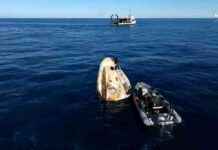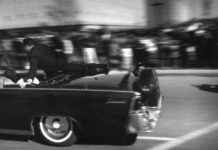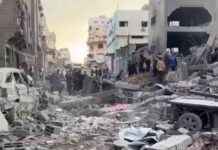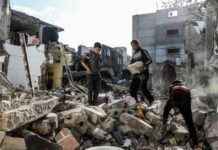Just now that Hollywood is celebrating the epic of Robert Oppenheimer, father of the atomic bomb, nuclear war is once again a threat to Europe. Pentagon strategists assess the possibility that Russian President Vladimir Putin will initiate an attack at 50%. They claim that in the fall of 2022, seeing how his army retreated in Ukraine, he was about to do it. The world has not been this close to a nuclear conflict since the Cuban missile crisis of 1962.
Thousands of Ukrainian doctors, nurses and paramedics have been trained to treat survivors of a nuclear attack. There are 200 hospitals prepared specifically for this. Millions of potassium iodine pills are kept in secret warehouses. They protect the thyroid from capturing cancer precursor radiation. There are thousands of radiation meters distributed throughout the country.
When announcing the invasion of Ukraine in February 2022, Putin threatened with the atomic bomb. Since then he has reiterated the message on several occasions, most recently the day before yesterday, during a televised interview. The Russian president insists that he will strike first if he sees Russia’s strategic interests in danger. His nuclear forces have been on high alert since February 28, 2022, nine days after invading Ukraine.
This threat has stopped the shipment of weapons to Ukraine and has so far prevented direct NATO intervention. “The fear of an escalation – said Ukrainian President Vladimir Zelensky – is the main obstacle to the defense of Ukraine. “Nothing has damaged our coalition more.”
Donald Trump, Republican candidate for the presidency of the United States, stated on February 10 that he will let Putin “do whatever he wants” with European NATO countries that do not spend 2% of their GDP on weapons. The idea that his victory in the November election will deprive Europe of the American nuclear umbrella has revived plans for a common European military, including an atomic deterrent force. Nuclear rearmament seems unstoppable.
German Finance Minister Christian Lindner believes that Europe should have its own nuclear arsenal. The former German foreign ministers Joschka Fischer and Sigmar Gabriel think the same. “If US aid to Ukraine is not increased, some countries will consider developing their own atomic bombs,” warned Radoslaw Sikorski, head of Polish diplomacy.
This would violate the Nuclear Non-Proliferation Treaty, which all EU countries, including Poland, have signed. “Building a bomb would be illegal,” explains analyst Philipp Sauter of the Max Planck Institute. “The only option that Europe has to defend itself without the North American umbrella that has protected it until now,” he adds, “would be for France to commit to defending any EU country with its atomic weapons.”
French President Emmanuel Macron does not want to commit so much. He prefers to maintain ambiguity about the use of the 300 atomic bombs in his arsenal. He has said, however, that it would be advisable to start preparing to send ground troops to Ukraine.
Putin responded to this strategy by saying, on February 29 in Moscow, during the annual state of the union address, that greater NATO involvement in Ukraine raises the risk of a nuclear confrontation.
In the fall of 2022, Ukraine launched an offensive that seemed unstoppable. He regained ground in Kharkiv, on the northern front, and recovered Kherson, in the south. The advance towards Crimea then seemed very plausible. If he broke the Russian defenses on the peninsula, the Pentagon was clear that Putin could attack Ukraine with a tactical, that is, low-intensity, nuclear bomb.
US military intelligence reported in October 2022 that the Kremlin was preparing an alibi to drop a bomb of this nature on Ukraine. The Strategic Command, the Pentagon unit that manages nuclear war, gauged the consequences. There would be thousands of deaths instantly. Access to the affected area would be impossible for days or weeks. Tens of thousands of people would die in the following weeks, even if the epicenter of the explosion was in open countryside.
Poland prepared for the worst. The United States sent him medical supplies and materials to measure radiation. Experts arrived to collect samples from the explosion.
Meanwhile, China, India and Türkiye tried to dissuade Russia. The G-20, meeting on November 16, showed a firm front against the Kremlin’s nuclear threat. The Ukrainian troops that had taken Kherson stopped at the Dniper River. Crimea was not threatened and Putin canceled the nuclear attack.
The world had not been this close to an atomic war since the crisis of 1962, when the USSR placed missiles in Cuba. So, the communication channels between Washington and Moscow were open and very fluid. Today, however, they are practically silent. Of the nuclear agreements signed after the missile crisis, only one remains in force, New START, although Putin suspended Russia’s participation last year.
Russia has about two thousand tactical nuclear bombs in its arsenal, distributed across many bases, including one in Belarus and another in the Kaliningrad enclave. The United States has deployed a hundred in six European countries: the United Kingdom, Belgium, the Netherlands, Italy, Germany and Turkey.
The American bombs are the B61-12. They are fired from fighter-bombers such as the F-35A. They have 340 kilotons of power, twenty times more than the Hiroshima bomb.
The United States can respond to a first Russian attack with a conventional one in Belarus or Russia itself, but, as expert Peter Dickinson of the Atlantic Council maintains, controlling the escalation “will be very difficult.” The Pentagon updated its “nuclear escalation scenarios” two years ago, on the occasion of the latest Russian invasion of Ukraine. Back then, no one considered that they were necessary. The threats were terrorism and cyber attacks. Now, there is no indication that a conventional response to a nuclear attack will serve to deter Putin, and the same can be said if he retaliates with a tactical nuclear bomb similar to the one Russia detonated in Ukraine.
Putin, as Dickinson explains, has shown that nuclear intimidation works and can trigger a new arms race: “If Russia normalizes nuclear intimidation as a foreign policy tool, many countries will rush to acquire their own nuclear weapons. Then, the possibility of an atomic war will skyrocket, as well as nuclear weapons falling into the hands of armed groups.”
This risk of escalation is also contemplated by researchers Stephen Cimbala, from the Public University of Pennsylvania, and Lawrence Korb, from the Center for American Progress, especially if Europe chooses to build its own nuclear arsenal. “Until now, dependence on the US arsenal has slowed proliferation, not only in Europe but also in South Korea and Japan. If these countries now feel threatened by their neighbors and doubt the protection of the United States, they can resort to their own atomic bombs.”
In any case, it is in Europe and specifically in Ukraine, where the danger is most imminent. Russia seems to be winning, but, between dead and wounded, it has lost 315,000 men, 90% of its entire army before the war. The nuclear option will be greater the smaller the possibilities of its conventional forces.
























